 During the pandemic, millions of people’s wages in the UK were paid by the government to prevent the closure of businesses and a surge in unemployment. The furlough scheme officially came to an end in September 2021. However, with the spread of the Omicron variant and the fear of further restrictions being put in place, there has been a call by many to re-introduce the furlough scheme.
During the pandemic, millions of people’s wages in the UK were paid by the government to prevent the closure of businesses and a surge in unemployment. The furlough scheme officially came to an end in September 2021. However, with the spread of the Omicron variant and the fear of further restrictions being put in place, there has been a call by many to re-introduce the furlough scheme.
The furlough scheme
The furlough scheme began when the government brought in, what was officially called the Coronavirus Job Retention Scheme (CJRS) in early 2020. This was when the pandemic first forced businesses across the country to close. The scheme worked by paying part of employees’ wages, preventing the need for businesses to make their staff redundant, therefore avoiding a rapid rise in unemployment along with the associated costs. It also avoided the financial and emotional costs of firing and then rehiring workers post pandemic. Under the scheme, furloughed workers received 80% of their wages, up to £2500 a month, if they couldn’t work because of the impact of coronavirus. Employees were able to maintain the security of employment and the payments helped furloughed workers pay their bills.
 The scheme saw billions of pounds spent paying the wages of employees whose firms were forced to close temporarily. It could be argued that the expense of the scheme was a huge disadvantage. However, the alternative would have been for the government to pay unemployment-related benefits. Despite the furlough scheme being deemed necessary, it was not without its drawbacks for the structure of businesses. Rather than businesses adapting to changes in the economy and consumer demands, they could decide to claim the money and avoid the need to restructure. There was also concern about the length of the furlough scheme and the ability of businesses to bounce back post-pandemic.
The scheme saw billions of pounds spent paying the wages of employees whose firms were forced to close temporarily. It could be argued that the expense of the scheme was a huge disadvantage. However, the alternative would have been for the government to pay unemployment-related benefits. Despite the furlough scheme being deemed necessary, it was not without its drawbacks for the structure of businesses. Rather than businesses adapting to changes in the economy and consumer demands, they could decide to claim the money and avoid the need to restructure. There was also concern about the length of the furlough scheme and the ability of businesses to bounce back post-pandemic.
Since the start of the scheme, the specifics of what was paid and who received it changed over time, especially once the economy started opening again. Initial steps were made to allow part-time return to work and the scheme started to wind down over the summer of 2021, with the government covering less of the wages and businesses covering more. From July, employers had to provide 10% of the wages of their furloughed staff, with the government paying the rest. This then increased to 20% in August with the CJRS coming to a complete end on 30 September 2021. At this point, there were around 1.6 million employees still receiving payment from the scheme.
Impact on Employment
With the end to the furlough scheme in September 2021, there were concerns that this would lead to a large number of redundancies. However, data indicate that has not happened and there is a record number of job vacancies. Official figures show that UK employment rose in October, confirming the strength of the labour market. The Office for National Statistics stated that the employment rate rose to 75.5% in the three months to October, up 0.2 percentage points on the previous quarter. This is believed to be driven by a rise in part-time work, which had dropped sharply during the pandemic. However, it is important to note that the strength in these numbers was prior to the emergence of the Omicron variant.
Omicron
 In November, the government had ruled out once again bankrolling people’s wages at enormous expense. However, the Chancellor is now under pressure to respond to the latest announcements around the ever-changing landscape of the pandemic. The fast-spreading mutation of the Covid-19 virus, Omicron, is posing a fresh threat to the economy.
In November, the government had ruled out once again bankrolling people’s wages at enormous expense. However, the Chancellor is now under pressure to respond to the latest announcements around the ever-changing landscape of the pandemic. The fast-spreading mutation of the Covid-19 virus, Omicron, is posing a fresh threat to the economy.
On the 8 December, the Prime Minister announced new ‘Plan B’ Covid rules for England. As part of these new rules to limit the spread of Omicron, people are being asked to work from home again if possible and face masks are compulsory in most public places. Covid passes or a negative Covid test result are also needed to get into nightclubs and large venues.
Scotland and Wales have brought in further restrictions. Scotland’s First Minister, Nicola Sturgeon, has asked people to limit socialising to three households at a time in the run-up to Christmas. Shops and hospitality venues in Scotland must bring back physical distancing and screens. In Wales, nightclubs will close after 26 December and social distancing will be reintroduced in shops.
 Although the hospitality industry and retail sector remain open, they are facing a slump in trade thanks to the new restrictions and worries among the general public. With the work-from-home guidance and advice from health officials that people should limit their social interactions, pubs and restaurants have seen widespread cancellations in the run-up to Christmas. Trade is suffering and these mass cancellations come at a time when these sectors were hoping for bumper trade after a dismal last couple of years.
Although the hospitality industry and retail sector remain open, they are facing a slump in trade thanks to the new restrictions and worries among the general public. With the work-from-home guidance and advice from health officials that people should limit their social interactions, pubs and restaurants have seen widespread cancellations in the run-up to Christmas. Trade is suffering and these mass cancellations come at a time when these sectors were hoping for bumper trade after a dismal last couple of years.
In light of these concerns, ministers are now being urged to guarantee support in case businesses have to shut. Despite the indication that it would be highly unlikely that the UK would experience a full return to the restrictions seen at previous stages of the crisis, the International Monetary Fund has stated that the UK government should be drawing up contingency plans. The IMF has called for a mini-furlough scheme in the event that the Omicron variant forces the government to close parts of the economy. The idea is that the mini-furlough scheme would see a limited version of the multi-billion-pound job subsidy scheme being rolled out if firms are forced to close.
There are strong calls for there to be targeted support, which this mini-furlough scheme could offer. The Resolution Foundation argued in mid-December that a furlough scheme tied solely to the hospitality industry would help prevent job loses in an industry that is currently suffering once again. It calculated that the cost of a hospitality-only furlough scheme would be £1.4 billion a month if it were pitched at the original level of 80% of wage support. If a January to March sector-specific scheme were to be introduced it is estimated to cost around £5 billion, a small cost in comparison to £46 billion spent on furlough so far.
Inflation
Any reintroduction of a furlough scheme would be a jolt for the government. This would mean a return to the 2020-style arguments around protecting livelihoods and businesses, a contrast to the recent messaging from the Treasury of restoring public finances. There is also concern about how this will all impact on current growth predictions and inflation concerns. The IMF expects the growth of the UK economy to be 6.8% in 2021 and 5% in 2022. However, the drawback from this is that the recovery would also be accompanied by rising inflation. It has been suggested, therefore, that interest rate increases from the Bank of England would be needed to keep inflation under control, while at the same time being not so great as to kill off growth.
It was widely expected that the Bank of England would again put off a rate hike in order to wait to see the economic impact of Plan B restrictions. However, on Thursday 16 December, interest rates were raised for the first time in more than three years. Despite the fears that Omicron could slow the economy by causing people to spend less, Bank Rate was raised from 0.1% to 0.25% . This came in the wake of data showing prices climbing at the fastest pace for 10 years.
Next Steps?
Government finances would take another huge hit if the furlough scheme were revived. But a version of such a scheme is likely to be necessary to avert an unemployment crisis and the attendant costs.
However, in resisting further measures, the government has argued that it has already acted early to help control the virus’s spread by rapidly rolling out booster jabs, while avoiding unduly damaging economic and social restrictions.
The government also argues that some of the measures from the total £400 billion Covid support package since the start of the pandemic will continue to help businesses into Spring 2022. Such measures include government-backed loans for small- and medium-sized businesses until June 2022, a reduction in VAT from 20% to 12.5% until March 2022 and business rates relief for eligible retail, hospitality, and leisure businesses until March 2022. Talks are ongoing with hospitality and and other business organisations directly affected by Covid restrictions.
The British Chambers of Commerce has argued that current measures are not enough and has called for VAT on hospitality and tourism to be cut back to its emergency rate of 5% and for the 100% business rates relief for retailers to return. The CBI has also called for any unspent local authority grants to be spent now to help affected firms and that further help, including business rates relief, should be on the table if restrictions continue after the government’s 5 January review date. The IMF said that with strong policy support, the economy had proved resilient, but it stressed that a return of some of the measures that prevented mass unemployment and large-scale business failures might soon be needed.
Conclusion
Infections caused by the new Omicron variant are rising rapidly, doubling every two to three days. It is expected to become the dominant variant in the UK soon with health officials warning it may be the most significant threat since the start of the pandemic. However, it is not yet known what the full extent of the impact of this new variant on the NHS will be, leaving the severity of future restrictions uncertain.
But what is evident is that the course of the pandemic has changed and there is a growing case for the government to start planning for new support packages. Although a reintroduction of the furlough scheme was hoped not to be needed on the path out of the pandemic, a short detour may be required in the form of a mini-furlough scheme. The size and reach of any support put in place will depend upon any further restrictions on economic activity.
Articles
Questions
- Should the level of support for business return to the levels in place earlier in 2021?
- What measures could a government put in place to curtail the spread of the Omicron variant that have only a minimal impact on business and employment?
- Compare the UK measures to curtail the spread of the virus with those used in some other European countries.
- What are the arguments for and against (a) re-introducing the furlough scheme as it was earlier in 2021; (b) introducing a version restricted to the hospitality sector?

The Climate Change Pact agreed by leaders at the end of COP26 in Glasgow went further than many pessimists had forecast, but not far enough to meet the goal of keeping global warming to 1.5°C above pre-industrial levels. The Pact states that:
limiting global warming to 1.5°C requires rapid, deep and sustained reductions in global greenhouse gas emissions, including reducing global carbon dioxide emissions by 45 per cent by 2030 relative to the 2010 level and to net zero around mid-century, as well as deep reductions in other greenhouse gases.
So how far would the commitments made in Glasgow restrict global warming and what actions need to be put in place to meet these commitments?
Short-term commitments and long-term goals
According to Climate Action Tracker, the short-term commitments to action that countries set out would cause global warming of 2.4°C by the end of the century, the effects of which would be calamitous in terms of rising sea levels and extreme weather.
However, long-term commitments to goals, as opposed to specific actions, if turned into specific actions to meet the goals would restrict warming to around 1.8°C by the end of the century. These long-term goals include reaching net zero emissions by certain dates. For the majority of the 136 countries agreeing to reach net zero, the date they set was 2050, but for some developing countries, it was later. China, Brazil, Indonesia, Russia, Nigeria, Sri Lanka and Saudi Arabia, for example, set a date of 2060 and India of 2070. Some countries set an earlier target and others, such as Benin, Bhutan, Cambodia, Guyana, Liberia and Madagascar, claimed they had already reached zero net emissions.
Despite these target dates, Climate Action Tracker argues that only 6 per cent of countries pledging net zero have robust policies in place to meet the targets. The problem is that actions are required by firms and individuals. They must cut their direct emissions and reduce the consumption of products whose production involved emissions.
 Governments can incentivise individuals and firms through emissions and product taxes, through carbon pricing, through cap-and-trade schemes, through subsidies on green investment, production and consumption, through legal limits on emissions, through trying to change behaviour by education campaigns, and so on. In each case, the extent to which individuals and firms will respond is hard to predict. People may want to reduce global warming and yet be reluctant to change their own behaviour, seeing themselves as too insignificant to make any difference and blaming big business, governments or rich individuals. It is important, therefore, for governments to get incentive mechanisms right to achieve the stated targets.
Governments can incentivise individuals and firms through emissions and product taxes, through carbon pricing, through cap-and-trade schemes, through subsidies on green investment, production and consumption, through legal limits on emissions, through trying to change behaviour by education campaigns, and so on. In each case, the extent to which individuals and firms will respond is hard to predict. People may want to reduce global warming and yet be reluctant to change their own behaviour, seeing themselves as too insignificant to make any difference and blaming big business, governments or rich individuals. It is important, therefore, for governments to get incentive mechanisms right to achieve the stated targets.
Let us turn to some specific targets specified in the Climate Change Pact.
Phasing out fossil fuel subsidies
Paragraph 20 of the Climate Change Pact
Calls upon Parties to accelerate … efforts towards the … phase-out of inefficient fossil fuel subsidies, while providing targeted support to the poorest and most vulnerable in line with national circumstances and recognizing the need for support towards a just transition.
Production subsidies include tax breaks or direct payments that reduce the cost of producing coal, oil or gas. Consumption subsidies cut fuel prices for the end user, such as by fixing the price at the petrol pump below the market rate. They are often justified as a way of making energy cheaper for poorer people. In fact, they provide a bigger benefit to wealthier people, who are larger users of energy. A more efficient way of helping the poor would be through benefits or general tax relief. Removing consumption subsidies in 32 countries alone would, according to International Institute for Sustainable Development, cut greenhouse gas emission by an average of 6 per cent by 2025.
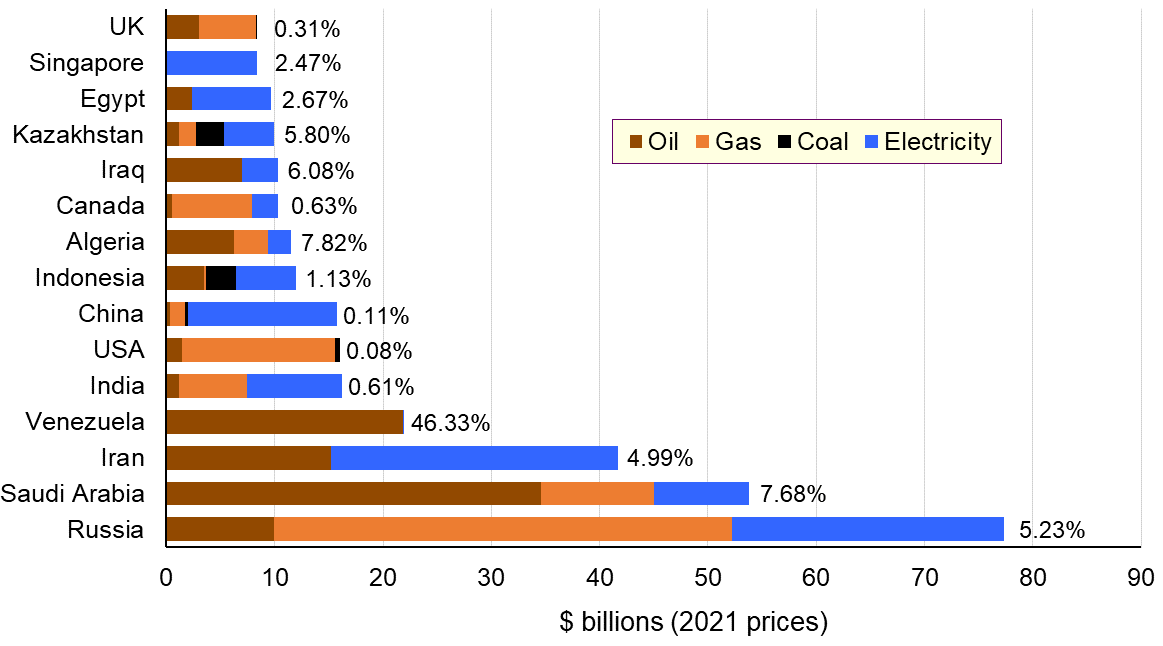 The chart shows the 15 countries providing the largest amount of support to fossil fuel industries in 2020 (in 2021 prices). The bars are in billions of dollars and the percentage of GDP is also given for each country. Subsidies include both production and consumption subsidies. (Click here for a PowerPoint of the chart.) In addition to the direct subsidies shown in the chart, there are the indirect costs of subsidies, including pollution, environmental destruction and the impact on the climate. According to the IMF, these amounted to $5.4 trillion in 2020.
The chart shows the 15 countries providing the largest amount of support to fossil fuel industries in 2020 (in 2021 prices). The bars are in billions of dollars and the percentage of GDP is also given for each country. Subsidies include both production and consumption subsidies. (Click here for a PowerPoint of the chart.) In addition to the direct subsidies shown in the chart, there are the indirect costs of subsidies, including pollution, environmental destruction and the impact on the climate. According to the IMF, these amounted to $5.4 trillion in 2020.
But getting countries to agree on a path to cutting subsidies, when conditions vary enormously from one country to another, proved very difficult.
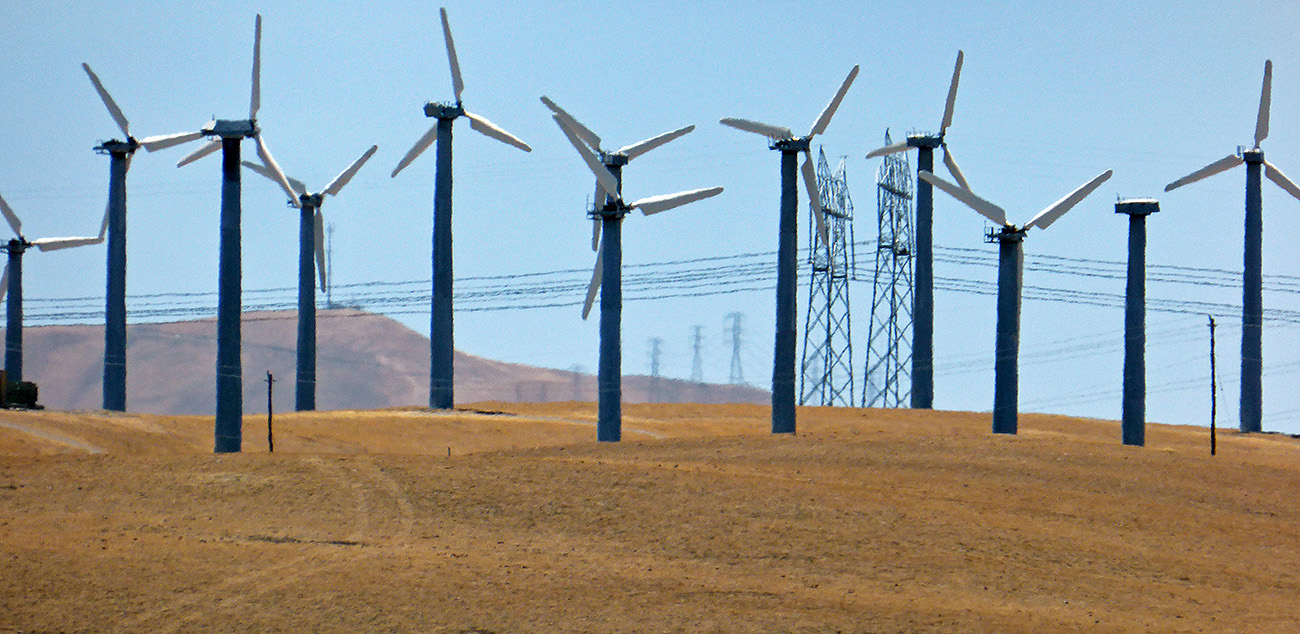 The first draft of the conference agreement called for countries to ‘to accelerate the phasing-out of coal and subsidies for fossil fuels’. But, after objections from major coal producing countries, such as China, India and Australia, this was weakened to calling on countries to accelerate the shift to clean energy systems ‘by scaling up the deployment of clean power generation and energy efficiency measures, including accelerating efforts towards the phasedown of unabated coal power and phase-out of inefficient fossil fuel subsidies’. (‘Unabated’ coal power refers to power generation with no carbon capture.) Changing ‘phasing-out’ to ‘the phasedown’ caused consternation among many delegates who saw this as a substantial weakening of the drive to end the use of coal.
The first draft of the conference agreement called for countries to ‘to accelerate the phasing-out of coal and subsidies for fossil fuels’. But, after objections from major coal producing countries, such as China, India and Australia, this was weakened to calling on countries to accelerate the shift to clean energy systems ‘by scaling up the deployment of clean power generation and energy efficiency measures, including accelerating efforts towards the phasedown of unabated coal power and phase-out of inefficient fossil fuel subsidies’. (‘Unabated’ coal power refers to power generation with no carbon capture.) Changing ‘phasing-out’ to ‘the phasedown’ caused consternation among many delegates who saw this as a substantial weakening of the drive to end the use of coal.
Another problem is in defining ‘inefficient’ subsidies. Countries are likely to define them in a way that suits them.
The key question was the extent to which countries would actually adopt such measures and what the details would be. Would they be strong enough? This remained to be seen.
As an article in the journal, Nature, points out:
There are three main barriers to removing production subsidies … First, fossil-fuel companies are powerful political groups. Second, there are legitimate concerns about job losses in communities that have few alternative employment options. And third, people often worry that rising energy prices might depress economic growth or trigger inflation.
The other question with the phasing out of subsidies is how and how much would there be ‘targeted support to the poorest and most vulnerable in line with national circumstances’.
Financial support for developing countries
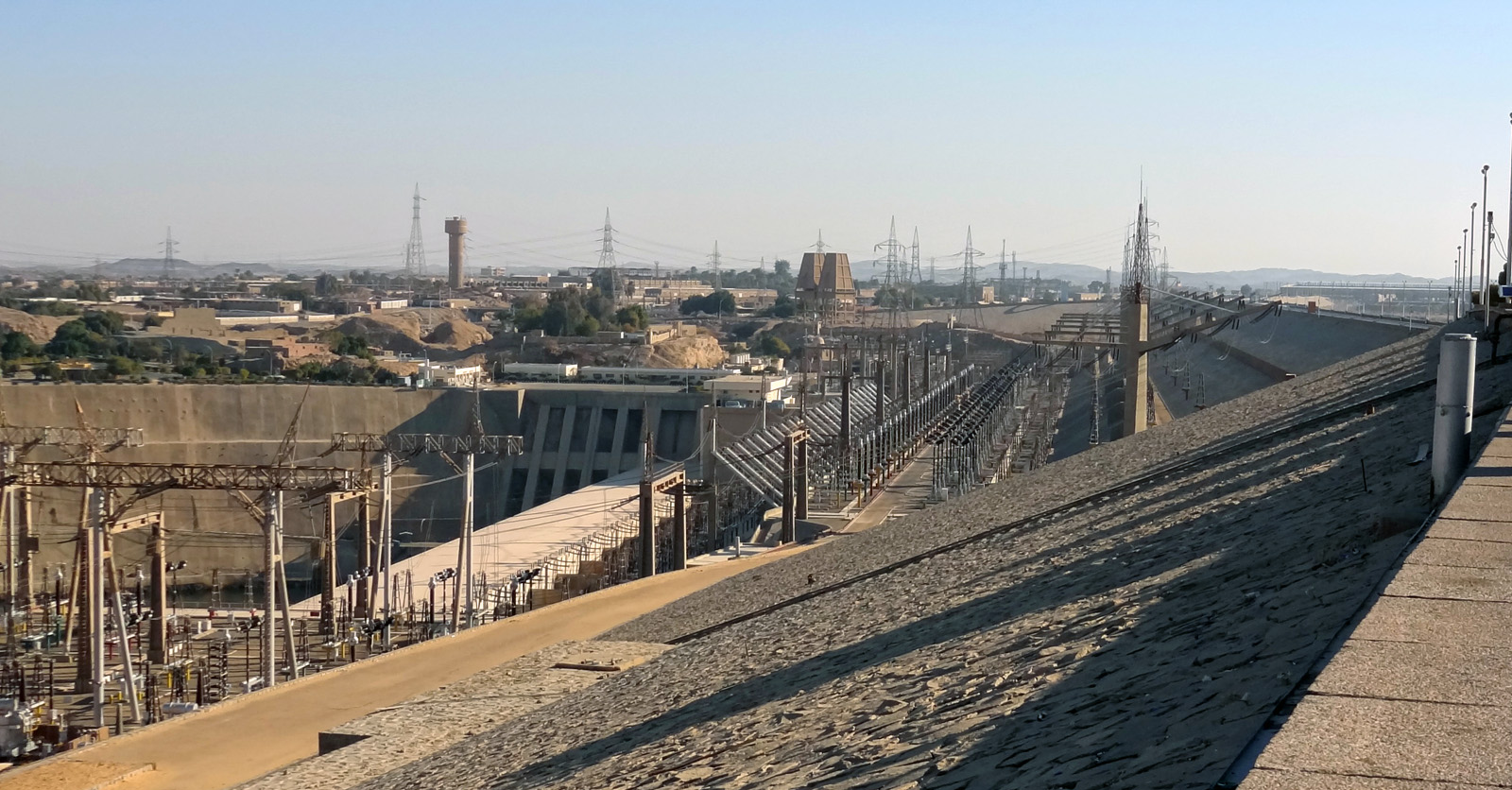 Transitioning to a low-carbon economy and investing in measures to protect people from rising sea levels, floods, droughts, fires, etc. costs money. With many developing countries facing serious financial problems, especially in the light of measures to support their economies and healthcare systems to mitigate the effects of COVID-19, support is needed from the developed world.
Transitioning to a low-carbon economy and investing in measures to protect people from rising sea levels, floods, droughts, fires, etc. costs money. With many developing countries facing serious financial problems, especially in the light of measures to support their economies and healthcare systems to mitigate the effects of COVID-19, support is needed from the developed world.
In the COP21 Paris Agreement in 2015, developed countries pledged $100 billion by 2020 to support mitigation of and adaptation to the effects of climate change by developing countries. But the target was not reached. The COP26 Pact urged ‘developed country Parties to fully deliver on the $100 billion goal urgently and through to 2025’. It also emphasised the importance of transparency in the implementation of their pledges. The proposal was also discussed to set up a trillion dollar per year fund from 2025, but no agreement was reached.
It remains to be seen just how much support will be given.
Then there was the question of compensating developing countries for the loss and damage which has already resulted from climate change. Large historical polluters, such as the USA, the UK and various EU countries, were unwilling to agree to a compensation mechanism, fearing that any recognition of culpability could make them open to lawsuits and demands for financial compensation.
Other decisions
- More than 100 countries at the meeting agreed to cut global methane emissions by at least 30 per cent from 2020 levels by 2030. Methane is a more powerful but shorter-living greenhouse gas than carbon. It is responsible for about a third of all human-generated global warming. China, India and Russia, however, did not sign up.
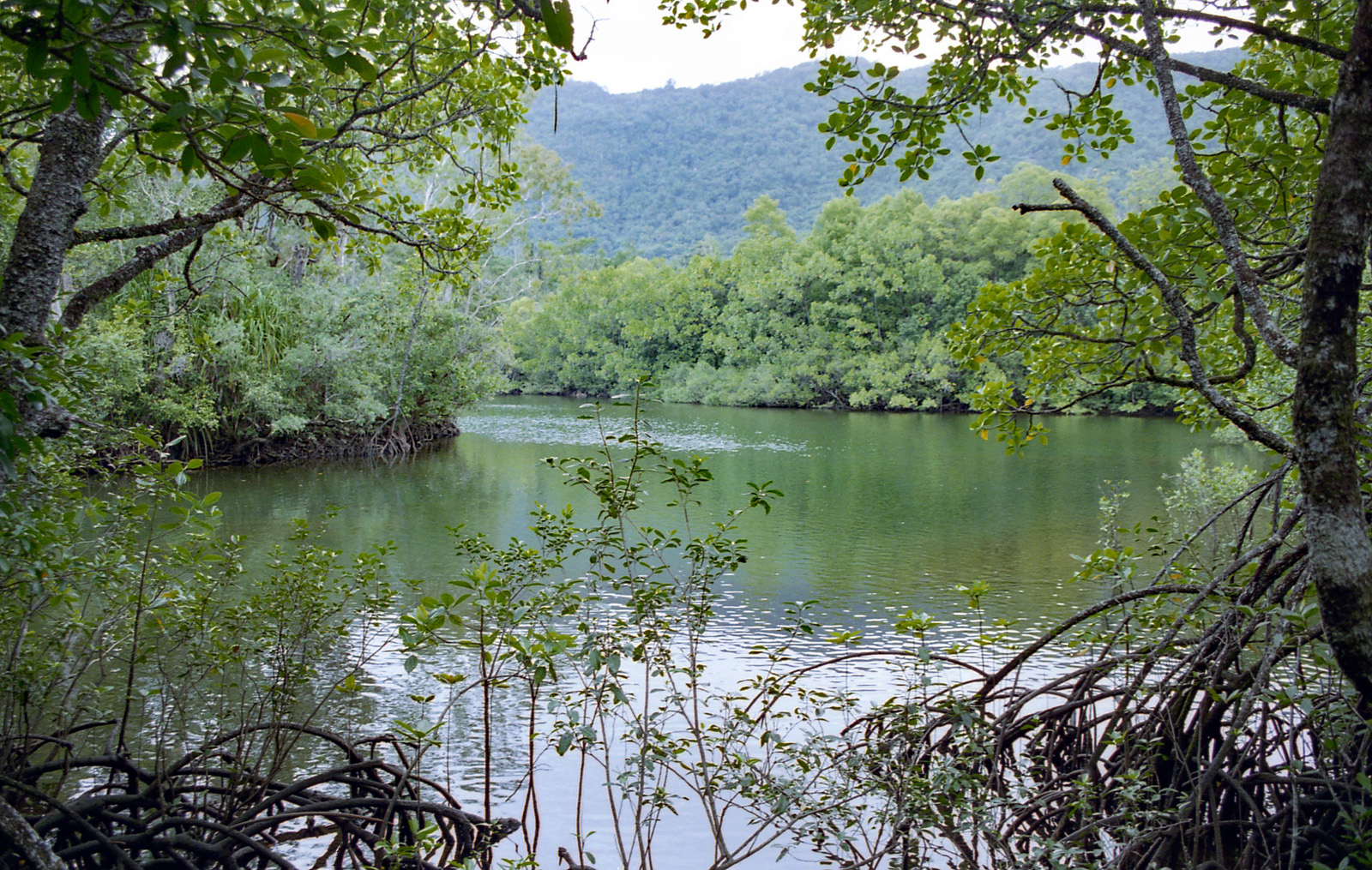 Again, more than 100 countries agreed to stop deforestation by 2030. These countries include Indonesia and Brazil, which has been heavily criticised for allowing large parts of the Amazon rainforest to be cleared for farming, such that the Amazon region in recent years has been a net emitter of carbon from the felling and burning of trees. The pledge has been met with considerable cynicism, however, as it unclear how it will be policed. Much of the deforestation around the world is already illegal but goes ahead anyway.
Again, more than 100 countries agreed to stop deforestation by 2030. These countries include Indonesia and Brazil, which has been heavily criticised for allowing large parts of the Amazon rainforest to be cleared for farming, such that the Amazon region in recent years has been a net emitter of carbon from the felling and burning of trees. The pledge has been met with considerable cynicism, however, as it unclear how it will be policed. Much of the deforestation around the world is already illegal but goes ahead anyway.- A mechanism for trading carbon credits was agreed. This allows countries which plant forests or build wind farms to earn credits. However, it may simply provide a mechanism for rich countries and businesses to keep emitting as usual by buying credits.
- Forty-five countries pledged to invest in green agricultural practices to make farming more sustainable.
- Twenty-two countries signed a declaration to create zero-emission maritime shipping routes.
- The USA and China signed a joint declaration promising to boost co-operation over the next decade on various climate actions, including reducing methane emissions, tackling deforestation and regulating decarbonisation.
 Blah, blah, blah or real action?
Blah, blah, blah or real action?
Many of the decisions merely represent targets. What is essential is for countries clearly to spell out the mechanisms they will use for achieving them. So far there is too little detail. It was agreed, therefore, to reconvene in a year’s time at COP27 in Egypt. Countries will be expected to spell out in detail what actions they are taking to meet their emissions targets and other targets such as ending deforestation and reducing coal-fired generation.
Articles
- COP26 ended with the Glasgow Climate Pact. Here’s where it succeeded and failed
CNN, Angela Dewan and Amy Cassidy (14/11/21)
- Good COP, Bad COP: Separating heat from light at the climate summit
Ing, Samuel Abettan, Gerben Hieminga and Coco Zhang (15/11/21)
- COP26: What was agreed at the Glasgow climate conference?
BBC News (15/11/21)
- Five Things You Need to Know About The New Glasgow Climate Pact
The Conversation, Simon Lewis and Mark Maslin (13/11/21)
- Infographic: What has your country pledged at COP26?
Aljazeera, Hanna Duggal (14/11/21)
- Cop26: world on track for disastrous heating of more than 2.4C, says key report
The Guardian, Fiona Harvey (9/11/21)
- Cop26 took us one step closer to combating the climate crisis
The Guardian, Christiana Figueres (15/11/21)
- After the failure of Cop26, there’s only one last hope for our survival
The Guardian, George Monbiot (14/11/21)
- Why fossil fuel subsidies are so hard to kill
Nature, Jocelyn Timperley (20/10/21)
- The COP26 blah blah blah detector
Rappler, Elpidio Peria (16/11/21)
Podcasts
Videos
Report
Document
Questions
- What were the main achievements of COP26?
- What were the main failings of COP26?
- How can people be incentivised to reduce their direct and indirect greenhouse gas emissions?
- How is game theory relevant to understanding the difficulties in achieving global net zero emissions?
- Should developing countries be required to give up coal power?
- If the world is to achieve net zero greenhouse gas emissions, should all countries achieve net zero or should some countries achieve net negative emissions to allow others to continue with net positive emissions (albeit at a lower level)?
 Many economists argue that the most effective policy for dealing with climate change is carbon pricing. This reduces greenhouse gas (GHG) emissions in a way that minimises the costs to the economy.
Many economists argue that the most effective policy for dealing with climate change is carbon pricing. This reduces greenhouse gas (GHG) emissions in a way that minimises the costs to the economy.
For the policy to work effectively it is important that the price per tonne of CO2 equivalent (CO2e) does not vary with the activity that causes the emissions. In other words, whether you drive a car, heat your house using gas or travel by air, the GHGs you create need to be priced at a unified rate.
Governments can introduce carbon pricing in two different ways – cap-and-trade schemes and carbon taxes.
With a cap-and-trade policy, emission allowances are either issued or sold to the organisations covered by the scheme. They must accumulate enough of these allowances to match the actual level of emissions they produce or pay a large fine. After the initial allocation, allowances can be bought and sold in a secondary market and prices can be quite volatile.
With a carbon tax, the government directly sets the price of GHGs through the tax rate but has less control over the quantity of emissions.
Policy in the UK
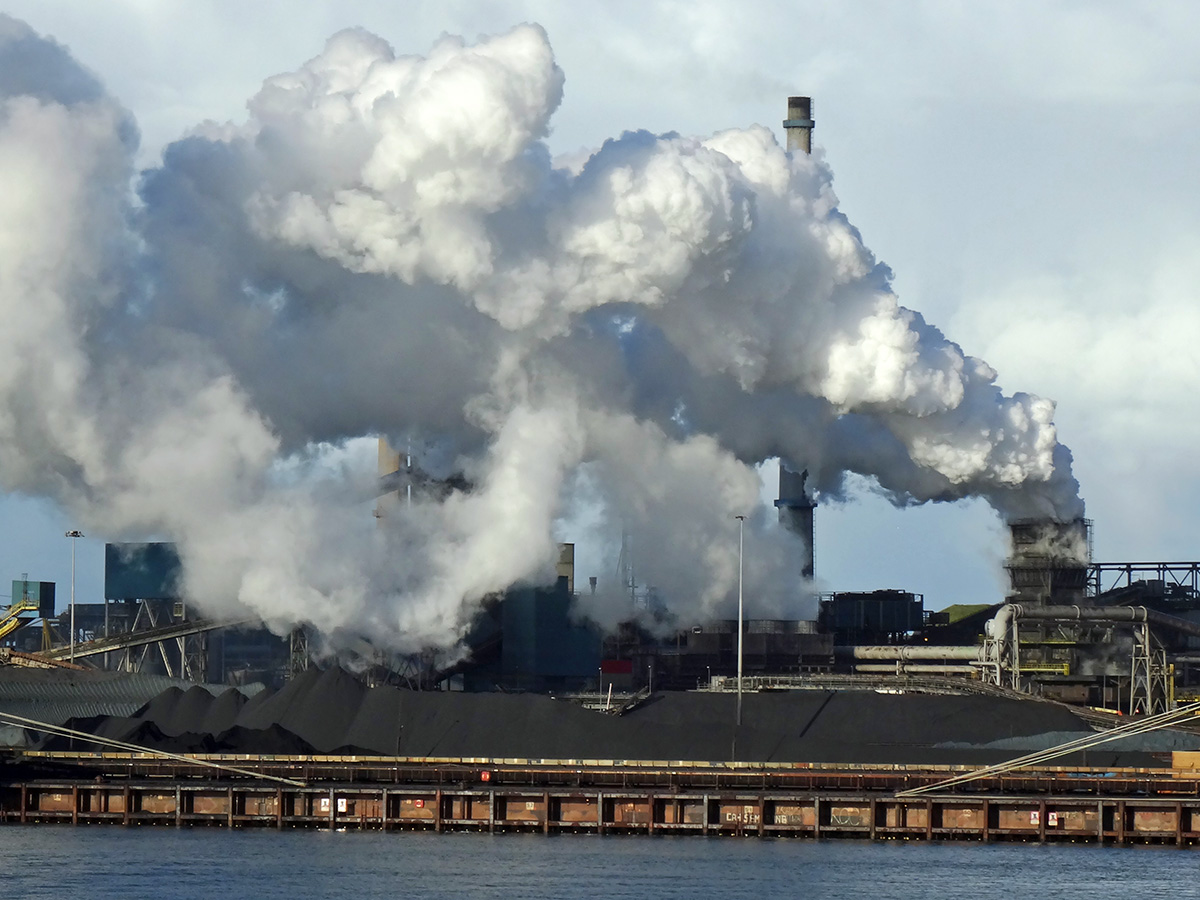 The UK Emissions Trading Scheme – an example of a cap-and-trade scheme – clearly places a price on GHG emissions. As this price is determined by market forces it can vary on a daily basis. The scheme applies to electricity generation and other energy-intensive industries that account for approximately 30 per cent of all emissions.
The UK Emissions Trading Scheme – an example of a cap-and-trade scheme – clearly places a price on GHG emissions. As this price is determined by market forces it can vary on a daily basis. The scheme applies to electricity generation and other energy-intensive industries that account for approximately 30 per cent of all emissions.
Although the UK does not have a specific carbon tax, it does have a number of different taxes that have an impact on the environment. Some of these have stated environmental objectives (e.g. the Climate Change Levy) while the main rationale for others is to raise revenue (fuel duty).
The tax rates are typically set on the output or consumption of the good rather than on emissions. For example, the Climate Change Levy applies to businesses’ use of electricity, gas and coal rather than the emissions the energy generates. Fuel duty depends on the amount of petrol consumed rather than the emissions the burning of that fuel generates. Clearly, emissions will tend to rise in proportion to the consumption/production of the good, but the relationship will not be precise.
The structure of VAT also influences emissions. The standard rate of VAT in the UK is 20 per cent. However, a lower level is applied to some goods/services that produce significant emissions. For example, the rate on household consumption of gas is 5 per cent while commercial passenger flights are zero rated. These lower tax rates are an implicit subsidy for the people who consume these goods/services. It makes them cheaper relative to the price of other goods.
Impact of the policies
Researchers from the Institute for Fiscal Studies have recently tried to analyse the impact of this complex range of policies on the price of carbon. The results indicate wide variations depending on the activity that causes the emissions.
One of the most significant differences is between gas and electricity. For example, non-energy-intensive businesses pay a price of £229.10 per tonne of CO2e from electricity generation but only £30.50 per tonne from burning gas. The response to the incentives this creates is unsurprising. One of the biggest contributing factors to the fall in territorial emissions in the UK has come from the decarbonisation of electricity supply: i.e. the switch away from coal-fired generation.
 The impact of government policy on UK households creates quite perverse incentives. Because of the lower rates of VAT, families receive an implicit subsidy of £24 per tonne CO2e when they use gas to heat their homes. When they use electricity, the source of energy that generates less emissions, they face a positive price of £137 per tonne of CO2e. Once again, the response to these incentives is unsurprising. Household emissions only fell by a relatively small amount between 1990 and 2018 because of the continued use of gas for heating and cooking.
The impact of government policy on UK households creates quite perverse incentives. Because of the lower rates of VAT, families receive an implicit subsidy of £24 per tonne CO2e when they use gas to heat their homes. When they use electricity, the source of energy that generates less emissions, they face a positive price of £137 per tonne of CO2e. Once again, the response to these incentives is unsurprising. Household emissions only fell by a relatively small amount between 1990 and 2018 because of the continued use of gas for heating and cooking.
Unsurprisingly many commentators have referred to carbon pricing in the UK as a confusing mess and have called for a unified rate across all activities to minimise the costs to the economy. Another important issue is the level at which a new unified rate is set. Some research by the Department for Business, Energy and Industrial Strategy suggests that the figure would have to be set between £122 and £36 per tonne of CO2e in order for the UK to reach its target of net zero emissions by 2050.
A higher unified rate would also create another problem – the distributional impact. Poorer households spend a much greater share of their income on electricity, heating and food and so would be disproportionately affected by the policy. For the policy to be politically acceptable, the government will need to find an effective way to compensate these groups.
Articles
Report
Questions
- Outline the difference between territorial and consumption emissions.
- Using the concepts of rivalry and excludability, explain why GHGs and the climate change they cause are an example of market failure.
- Discuss the main differences between cap-and trade schemes and carbon emission taxes.
- Explain why a unified carbon price would minimise the costs to the economy of reducing the level of GHG emissions.
- Discuss some of the potential limitations of introducing carbon pricing and explain why some countries are considering the implementation of a Carbon Border Adjustment mechanism.
 Inflation has surged worldwide as countries have come out of their COVID-19 lockdowns. The increases in prices combined with supply-chain problems has raised questions of what will happen to future prices and whether it will feed further inflation cycles.
Inflation has surged worldwide as countries have come out of their COVID-19 lockdowns. The increases in prices combined with supply-chain problems has raised questions of what will happen to future prices and whether it will feed further inflation cycles.
Inflation targeting
Inflation is a key contributor to instability in an economy. It measures the rate of increases in prices over a given period of time and indicates what will happen to the cost of living for households. Because of its importance, many central banks aim to keep inflation low and steady by setting a target. The Bank of England, the Federal Reserve, and the European Central Bank all aim to keep inflation low at a target rate of 2 per cent.
Inflation-rate targeting has been successfully practised in a growing number of countries over the past few decades. However, measures to combat rising inflation typically contract the economy through reducing real aggregate demand (or at least its rate of growth). This is a concern when the economy is not experiencing a strong economic performance.
Current outlook
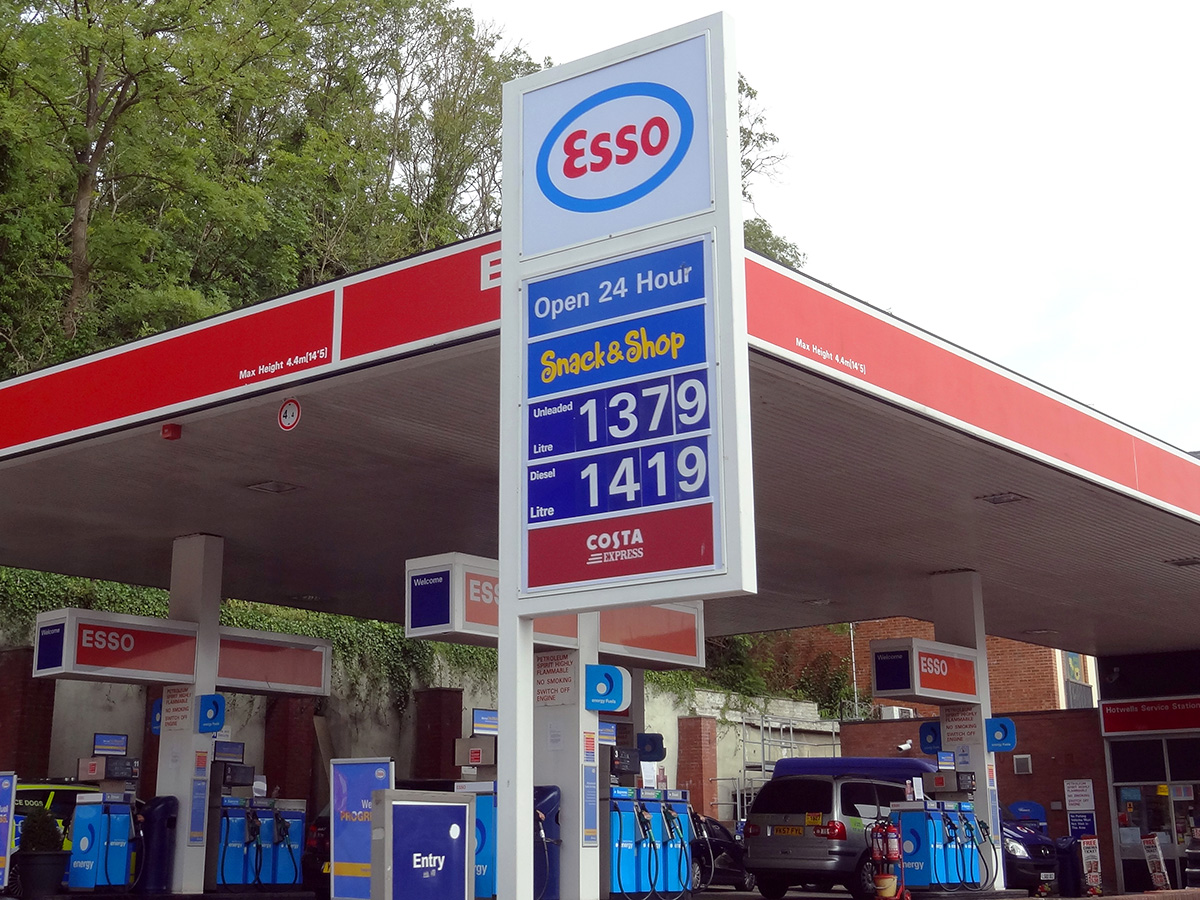 Globally, rising inflation is causing concern as a surge in demand has been confronted by supply bottlenecks and rising prices of energy and raw materials. As the world emerges from the COVID-19 lockdowns, global financial markets have been affected in recent months by concerns around inflation. They have also been affected by the prospect of major central banks around the world being forced into the early removal of pandemic support measures, such as quantitative easing, before the economic recovery from the coronavirus is complete.
Globally, rising inflation is causing concern as a surge in demand has been confronted by supply bottlenecks and rising prices of energy and raw materials. As the world emerges from the COVID-19 lockdowns, global financial markets have been affected in recent months by concerns around inflation. They have also been affected by the prospect of major central banks around the world being forced into the early removal of pandemic support measures, such as quantitative easing, before the economic recovery from the coronavirus is complete.
The Chief Economist at the Bank of England has warned that UK inflation is likely to rise ‘close to or even slightly above 5 per cent’ early next year, as he said the central bank would have a ‘live’ decision on whether to raise interest rates at its November meeting. Although consumer price inflation dipped to 3.1 per cent in September, the Bank of England has forecast it to exceed 4 per cent by the end of the year, 2 percentage points higher than its target. UK banks and building societies have already started to increase mortgage rates in response to rising inflation, signalling an end to the era of ultra-low borrowing costs and piling further pressure on household finances.
In the USA, shortages throughout the supply chains on which corporate America depends are also causing concern. These issues are translating into widespread inflationary pressure, disrupting operations and forcing companies to raise prices for customers. Pressure on every link in the supply chain, from factory closures triggered by COVID-19 outbreaks to trouble finding enough staff to unload trucks, is rippling across sectors, intensifying questions about the threat that inflation poses to robust consumer spending and rebounding corporate earnings. Reflecting concern over weaker levels of global economic growth despite rising inflationary pressures, US figures published at the end of October showed the world’s largest economy added just 194 000 jobs in September, far fewer than expected.
There are also fears raised over high levels of corporate debt, including in China at the embattled property developer Evergrande, where worries over its ability to keep up with debt payments have rippled through global markets. There are major concerns that Evergrande could pose risks to the wider property sector, with potential spill-overs internationally. However, it is argued that the British banking system has been shown in stress tests to be resilient to a severe economic downturn in China and Hong Kong.
Central bank responses
The sharpest consumer-price increases in years have evoked different responses from central banks. Many have raised interest rates, but two that haven’t are the most prominent in the global economy: the Federal Reserve and the European Central Bank. These differences in responses reflect differing opinions as to whether current price increases will feed further inflation cycles or simply peter out. For those large central banks, they are somewhat relying on households keeping faith in their track record of keeping inflation low. There is also an expectation that there are enough underutilised workers to ensure that wage inflation is kept low.
 However, other monetary authorities worry that they have not yet earned the record of keeping inflation low and are concerned about the risk of wage inflation. In addition, in poorer countries there is a larger share of spending that goes on essentials such as food and energy. These have seen some of the highest price increases, so policy makers are going to be keen to stamp down on the inflation.
However, other monetary authorities worry that they have not yet earned the record of keeping inflation low and are concerned about the risk of wage inflation. In addition, in poorer countries there is a larger share of spending that goes on essentials such as food and energy. These have seen some of the highest price increases, so policy makers are going to be keen to stamp down on the inflation.
The Federal Reserve is expected to announce that it will start phasing out its $120bn monthly bond-buying programme (quantitative easing) as it confronts more pronounced price pressures and predictions that interest rates will be lifted next year. However, no adjustments are expected to be made to the Fed’s main policy rate, which is tethered near zero. Whilst financial markets are betting on an rise in Bank Rate by the Bank of England as early as next month, spurred by comments from Governor Andrew Bailey in mid-October that the central bank would ‘have to act’ to keep a lid on inflation.
Outlook for the UK
 The Bank of England’s Chief Economist, Huw Pill, has warned that high rates of inflation could last longer than expected, due to severe supply shortages and rising household energy bills. He said inflationary pressures were still likely to prove temporary and would fall back over time as the economy adjusted after disruption caused by COVID and Brexit. However, he warned there were growing risks that elevated levels of inflation could persist next year.
The Bank of England’s Chief Economist, Huw Pill, has warned that high rates of inflation could last longer than expected, due to severe supply shortages and rising household energy bills. He said inflationary pressures were still likely to prove temporary and would fall back over time as the economy adjusted after disruption caused by COVID and Brexit. However, he warned there were growing risks that elevated levels of inflation could persist next year.
The looming rise in borrowing costs for homeowners will add further pressure to family finances already stretched by higher energy bills and surging inflation. According to the Institute for Fiscal Studies, it is expected that households will face years of stagnating living standards, with predictions showing that households would on average be paying £3000 more each year in taxes by 2024/25, with the biggest impact felt by higher earners.
Investors are also reacting to concerns and have pulled $9.4bn out of UK-focused equity funds this year after hopes that a COVID-19 vaccination drive will fuel a vigorous economic recovery were overshadowed by questions about slow growth and high inflation. It is suggested that there is a general sense of caution about the UK when it comes to investing globally, driven by monetary, fiscal and trade uncertainties.
Given all the elements contributing to this outlook, The IMF has forecast that the UK will recover more slowly from the shocks of coronavirus than other G7 nations, with economic output in 2024 still 3 per cent below its pre-pandemic levels. Financial markets are predicting the Bank of England will lift interest rates as soon as the next MPC meeting. And while supply-chain bottlenecks and rising commodity prices are a global trend, the Bank’s hawkish stance has increased the possibility of a sharper slowdown in Britain than other developed markets, some analysts have said.
What next?
Some of the major central banks are poised to take centre stage when announcing their next monetary action, as it will reveal if they share the alarm about surging inflation that has gripped investors. Markets are betting that the Bank of England will begin raising interest rates, with Bank Rate expected to rise to around 1.25 per cent by the end of next year (from the current 0.1 per cent).
It is thought that the Fed will not raise interest rates just yet but will do so in the near future. Markets, businesses, and households globally will be waiting on the monetary decisions of all countries, as these decisions will shape the trajectory of the global economy over the next few years.
Articles
- Three Days Will Reveal Global Alert Level on Inflation: Eco Week
Bloomberg, Molly Smith and Craig Stirling (31/10/21)
- Inflation watch: Global food prices hit 10-year high
Al Jazeera (4/11/21)
- Fed sings the ‘transitory’ inflation refrain, unveils bond-buying ‘taper’
ReutersHoward Schneider and Ann Saphir (3/11/21)
- BoE chief economist warns UK inflation likely to hit 5%
Financial Times, Chris Giles (21/10/21)
- Inflation pressure now ‘brutal’ because of supply squeeze, US companies say
Financial Times, Andrew Edgecliffe-Johnson, Matthew Rocco, Obey Manayiti and Claire Bushey (23/10/21)
- Rising inflation could trigger global sell-off that would harm UK, says Bank
The Guardian, Richard Partington (8/10/21)
- Bank of England chief economist warns high inflation rates may persist in 2022
The Guardian, Richard Partington (7/10/21)
- Bank of England surprises markets by holding rates at record lows
CNBC, Elliot Smith (4/11/21)
 Bank of England resists pressure to raise interest rates as inflation spike looms
Bank of England resists pressure to raise interest rates as inflation spike loomsSky News, Ed Conway (4/11/21)
Forecasts and commentary
Questions
- What is the definition of inflation?
- How is inflation measured?
- Using a diagram to aid your answers, discuss the difference between cost-push and demand-pull inflation.
- What are the demand-side and cost-side causes of the current rising inflation?
- Explain the impact an increase in interest rates has on the economy.
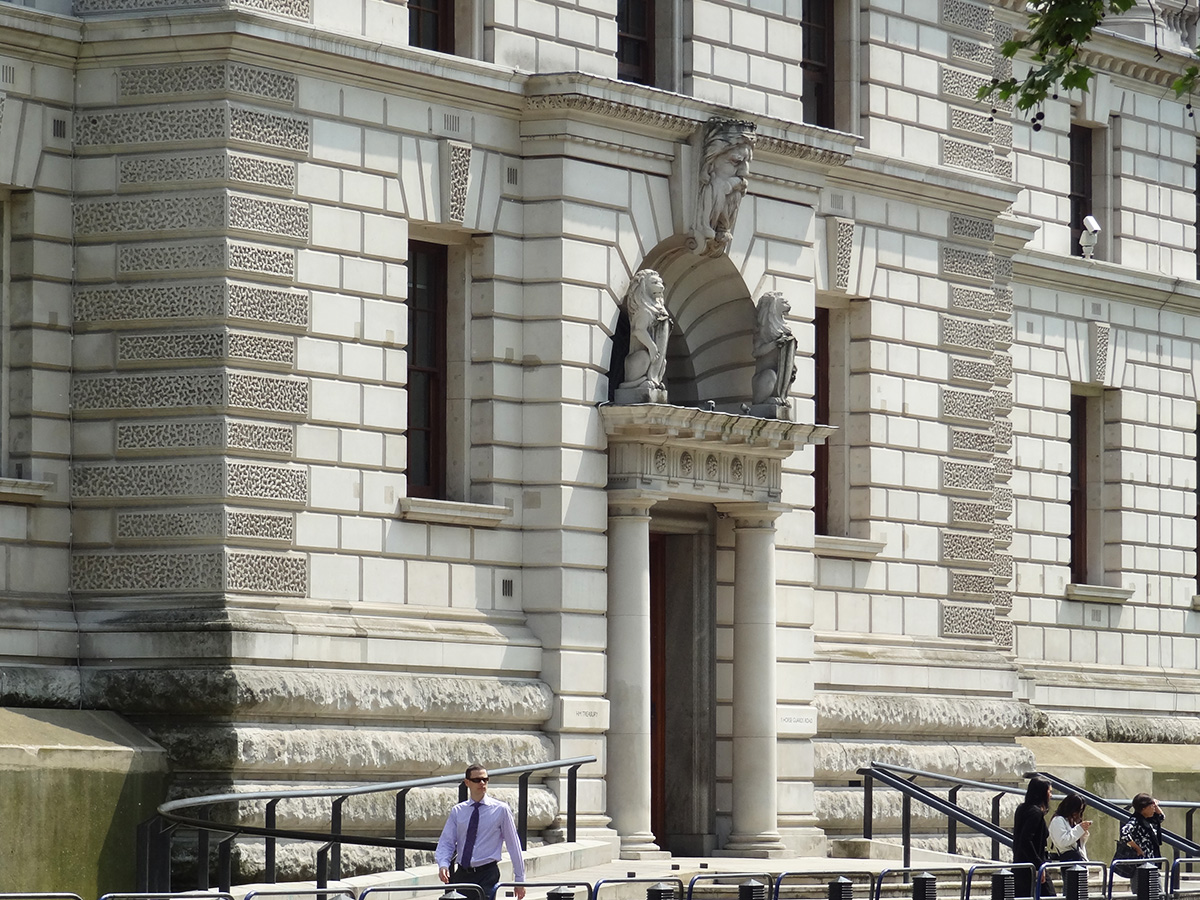 The UK government has made much of its spending commitments in the UK Budget and Spending Review delivered on 27 October 2021. Spending on transport infrastructure, green energy and health care figured prominently. The government claimed that these were to help achieve its objectives of economic growth, carbon reduction and ‘levelling up’. This means that government expenditure will be around 42% of GDP for the five years from 2022 (from 1988 to 2000 it averaged 36%). Although it temporarily rose to 52% in 2020/21, this was the result of supporting the economy through the pandemic. But does this mean that the government is now a ‘Keynesian’ one?
The UK government has made much of its spending commitments in the UK Budget and Spending Review delivered on 27 October 2021. Spending on transport infrastructure, green energy and health care figured prominently. The government claimed that these were to help achieve its objectives of economic growth, carbon reduction and ‘levelling up’. This means that government expenditure will be around 42% of GDP for the five years from 2022 (from 1988 to 2000 it averaged 36%). Although it temporarily rose to 52% in 2020/21, this was the result of supporting the economy through the pandemic. But does this mean that the government is now a ‘Keynesian’ one?
When the economy is in recession, as was the case in 2020 with the effects of the pandemic, increased government expenditure financed by borrowing rather than taxation is the classic Keynesian remedy to boost aggregate demand and close the output gap. The increased injection of spending works through the multiplier process to raise equilibrium national income and reduce unemployment.
But is this the objective of the extra spending announced in October 2021? To answer this, it is important to look at forecasts for the state of the economy with no change in government policy and at the balance of government expenditure and taxation resulting from the Budget. The first chart shows public sector net borrowing from 2006/7 and forecast to 2026/7. The green and red lines from 2021/22 onwards give the PSNB forecasts with and without the October 2021 measures.
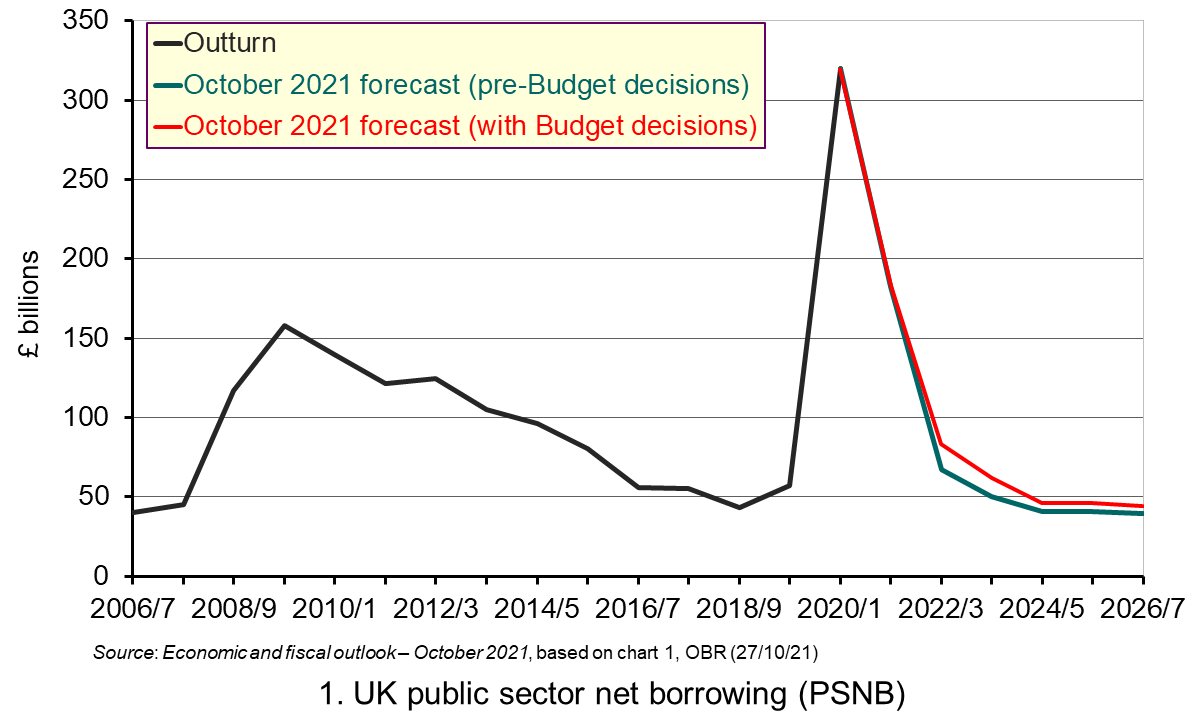 As you can see, there was a large increase in the PSNB in 2020/21, reflecting the government’s measures to support firms and workers during the pandemic. (Click here for a PowerPoint of the chart.) This was very much a Keynesian response, where a large budget deficit was necessary to support aggregate demand. It was also to protect the supply side of the economy by enabling firms to survive.
As you can see, there was a large increase in the PSNB in 2020/21, reflecting the government’s measures to support firms and workers during the pandemic. (Click here for a PowerPoint of the chart.) This was very much a Keynesian response, where a large budget deficit was necessary to support aggregate demand. It was also to protect the supply side of the economy by enabling firms to survive.
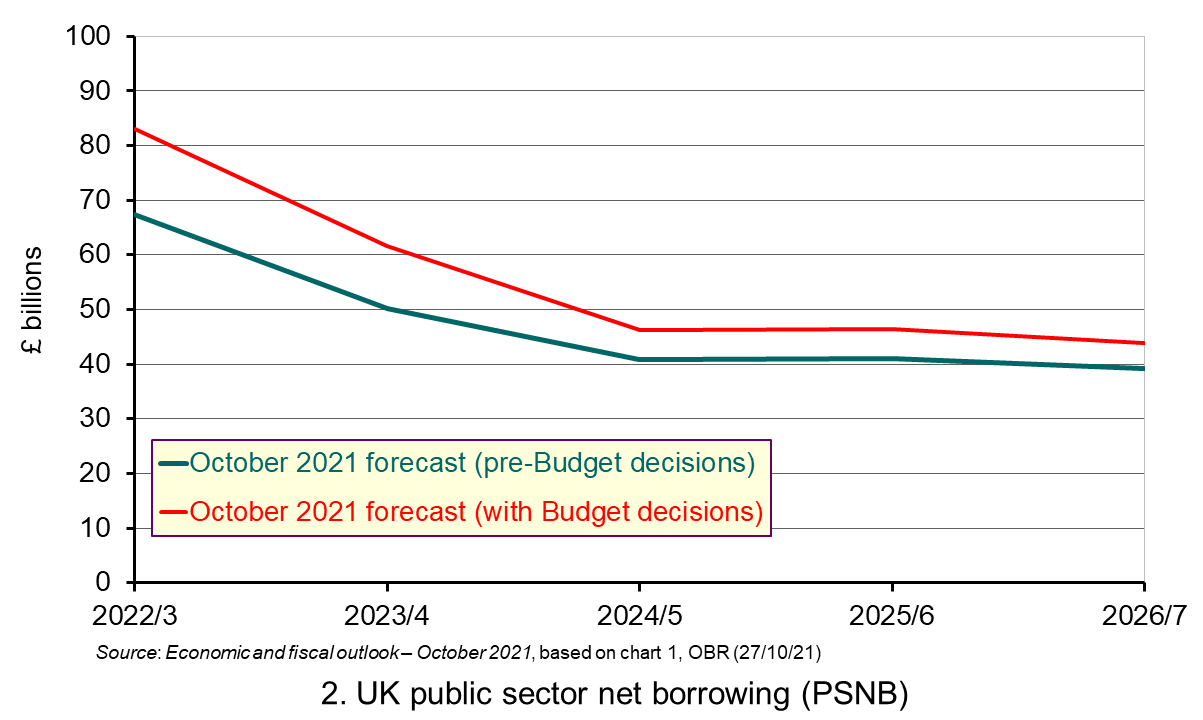 But could the October 2021 announcements also be seen as a Keynesian response to the macroeconomic situation? If we redraw Chart 1, focusing just on the forecast period and adjust the vertical scale, we can see that the measures have a net effect of increasing the PSNB and thus acting as a stimulus to aggregate demand. (Click here for a PowerPoint of the chart.) The figures are shown in the following table, which shows the totals from Table 5.1 in the Autumn Budget and Spending Review 2021 document:
But could the October 2021 announcements also be seen as a Keynesian response to the macroeconomic situation? If we redraw Chart 1, focusing just on the forecast period and adjust the vertical scale, we can see that the measures have a net effect of increasing the PSNB and thus acting as a stimulus to aggregate demand. (Click here for a PowerPoint of the chart.) The figures are shown in the following table, which shows the totals from Table 5.1 in the Autumn Budget and Spending Review 2021 document:
Effects of Spending Review and Budget 2021 on PSNB (+ = increase in PSNB)

At first sight, it would seem that the Budget was mildly expansionary. To see how much so, the Office for Budget Responsibility (OBR) measures the ‘fiscal stance’ using the ‘cyclically adjusted primary deficit (CAPD)’. This is PSNB minus interest payments and minus expenditures and tax revenues that fluctuate with the cycle and which therefore act as automatic stabilisers. The OBR’s forecast of the CAPD shows it to be expansionary, but decreasing over time. In 2021/22, there is forecast to be a net injection of around 3.2% (excluding ‘virus-related’ support), falling to 2.7% in 2022/23 and then gradually to around 0.6% by 2026/27. So it does seem that fiscal policy remains expansionary throughout the period, but less and less so.
But this alone does not make it ‘Keynesian’. A Keynesian Budget would be one that uses fiscal policy to adjust aggregate demand (AD) according to whether AD is forecast to be deficient or excessive without the Budget measures. To operate a Keynesian Budget, it would be necessary to forecast the output gap without any policy measures. If was forecast to be negative (a deficiency of demand, with equilibrium output below the potential level), then an expansionary policy should be pursued by raising government expenditure, cutting taxes or some combination of the two. If it was forecast to be positive (an excess demand, with equilibrium output above the potential level), then a contractionary/deflationary policy should be pursued by cutting government expenditure, raising taxes or some combination of the two.
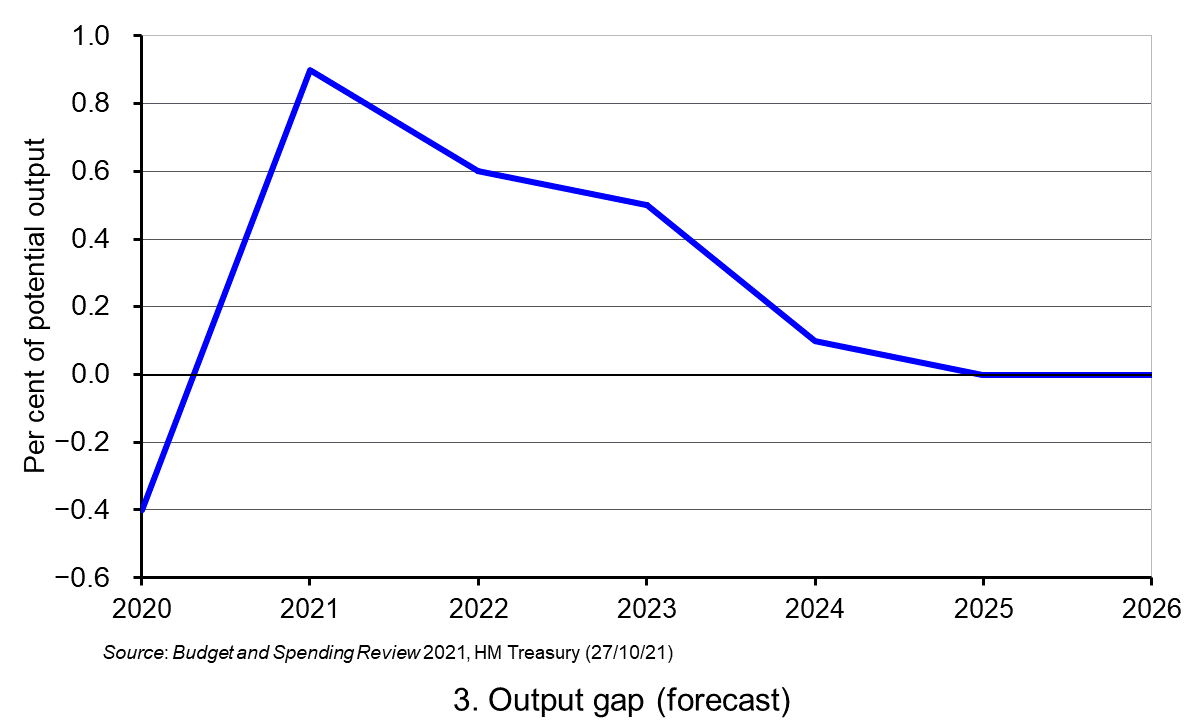 So what is the forecast for the output gap? The OBR states that, after being negative in 2020
So what is the forecast for the output gap? The OBR states that, after being negative in 2020
(–0.4% of potential GDP), it has risen substantially to 0.9% in 2021 with the rapid bounce back from the pandemic. But it is forecast to remain positive, albeit declining, until reaching zero in 2025. This is illustrated in Chart 3. (Click here for a PowerPoint of the chart.) So fiscal policy remains mildly expansionary until 2025, after having provided a considerable stimulus in 2021.
This is not normally what a Keynesian economist would recommend. Fiscal policy should be designed to achieve a zero output gap. With the output gap being substantially positive in 2021, there is a problem of excess demand. This can be seen in supply-chain difficulties and labour shortages in certain areas and higher inflation, with CPI inflation predicted by the OBR to rise to 4.4 per cent in 2022. The combination of higher prices, the rise in national insurance from April 2022 by 1.25 percentage points and the freezing of income tax personal allowances will squeeze living standards. And the cancelling of the £20 per week uplift to Universal Credit and no increase in its rate for the unemployed will put particular pressure on some of the poorest people.
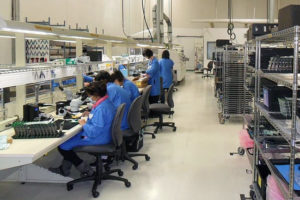 The government is hoping that the rise in government expenditure will have beneficial supply-side effects and increase potential national income. The aim is to create a high-wage, high-skilled, high-productivity economy though investment in innovation, infrastructure and skills. As the OBR states, ‘The rebounding economy has provided the Chancellor with a Budget windfall that he has added to with tax rises that lift the tax burden to its highest since the early 1950s’.
The government is hoping that the rise in government expenditure will have beneficial supply-side effects and increase potential national income. The aim is to create a high-wage, high-skilled, high-productivity economy though investment in innovation, infrastructure and skills. As the OBR states, ‘The rebounding economy has provided the Chancellor with a Budget windfall that he has added to with tax rises that lift the tax burden to its highest since the early 1950s’.
It remains to be seen whether the extra spending on education, training, infrastructure and R&D will be sufficient to achieve the long-term growth the Chancellor is seeking. The OBR is forecasting very modest growth into the longer term when the bounce back has worked through. Real GDP is forecast to grow on average by just 1.5% per year from 2024 to 2026. What is more, the OBR sees permanent scarring effects of around 2% of GDP from the pandemic and around 4% of GDP from Brexit.
Articles
Analysis
Documents
Data
Questions
- What do you understand by ‘fiscal stance’?
- What are ‘automatic fiscal stabilisers? How might they affect GDP over the next few years?
- If the government had chosen to pursue a zero output gap from 2022/23 onwards, how would this have affected the balance between total government expenditure and taxation in the 2021 Budget and Spending Review?
- Provide a critique of the Budget from the left.
- Provide a critique of the budget from the right.
- Was this a ‘Green Budget’?
- Is the Budget following the ‘golden rule’ of fiscal policy?
- Look through Table 5.1 in the Budget and Spending Review document (linked below). Which of the measures will have the most substantial effect on aggregate demand?
 During the pandemic, millions of people’s wages in the UK were paid by the government to prevent the closure of businesses and a surge in unemployment. The furlough scheme officially came to an end in September 2021. However, with the spread of the Omicron variant and the fear of further restrictions being put in place, there has been a call by many to re-introduce the furlough scheme.
During the pandemic, millions of people’s wages in the UK were paid by the government to prevent the closure of businesses and a surge in unemployment. The furlough scheme officially came to an end in September 2021. However, with the spread of the Omicron variant and the fear of further restrictions being put in place, there has been a call by many to re-introduce the furlough scheme.  The scheme saw billions of pounds spent paying the wages of employees whose firms were forced to close temporarily. It could be argued that the expense of the scheme was a huge disadvantage. However, the alternative would have been for the government to pay unemployment-related benefits. Despite the furlough scheme being deemed necessary, it was not without its drawbacks for the structure of businesses. Rather than businesses adapting to changes in the economy and consumer demands, they could decide to claim the money and avoid the need to restructure. There was also concern about the length of the furlough scheme and the ability of businesses to bounce back post-pandemic.
The scheme saw billions of pounds spent paying the wages of employees whose firms were forced to close temporarily. It could be argued that the expense of the scheme was a huge disadvantage. However, the alternative would have been for the government to pay unemployment-related benefits. Despite the furlough scheme being deemed necessary, it was not without its drawbacks for the structure of businesses. Rather than businesses adapting to changes in the economy and consumer demands, they could decide to claim the money and avoid the need to restructure. There was also concern about the length of the furlough scheme and the ability of businesses to bounce back post-pandemic.  In November, the government had ruled out once again bankrolling people’s wages at enormous expense. However, the Chancellor is now under pressure to respond to the latest announcements around the ever-changing landscape of the pandemic. The fast-spreading mutation of the Covid-19 virus, Omicron, is posing a fresh threat to the economy.
In November, the government had ruled out once again bankrolling people’s wages at enormous expense. However, the Chancellor is now under pressure to respond to the latest announcements around the ever-changing landscape of the pandemic. The fast-spreading mutation of the Covid-19 virus, Omicron, is posing a fresh threat to the economy.  Although the hospitality industry and retail sector remain open, they are facing a slump in trade thanks to the new restrictions and worries among the general public. With the work-from-home guidance and advice from health officials that people should limit their social interactions, pubs and restaurants have seen widespread cancellations in the run-up to Christmas. Trade is suffering and these mass cancellations come at a time when these sectors were hoping for bumper trade after a dismal last couple of years.
Although the hospitality industry and retail sector remain open, they are facing a slump in trade thanks to the new restrictions and worries among the general public. With the work-from-home guidance and advice from health officials that people should limit their social interactions, pubs and restaurants have seen widespread cancellations in the run-up to Christmas. Trade is suffering and these mass cancellations come at a time when these sectors were hoping for bumper trade after a dismal last couple of years. 
 Governments can incentivise individuals and firms through emissions and product taxes, through carbon pricing, through cap-and-trade schemes, through subsidies on green investment, production and consumption, through legal limits on emissions, through trying to change behaviour by education campaigns, and so on. In each case, the extent to which individuals and firms will respond is hard to predict. People may want to reduce global warming and yet be reluctant to change their own behaviour, seeing themselves as too insignificant to make any difference and blaming big business, governments or rich individuals. It is important, therefore, for governments to get incentive mechanisms right to achieve the stated targets.
Governments can incentivise individuals and firms through emissions and product taxes, through carbon pricing, through cap-and-trade schemes, through subsidies on green investment, production and consumption, through legal limits on emissions, through trying to change behaviour by education campaigns, and so on. In each case, the extent to which individuals and firms will respond is hard to predict. People may want to reduce global warming and yet be reluctant to change their own behaviour, seeing themselves as too insignificant to make any difference and blaming big business, governments or rich individuals. It is important, therefore, for governments to get incentive mechanisms right to achieve the stated targets. The chart shows the 15 countries providing the largest amount of support to fossil fuel industries in 2020 (in 2021 prices). The bars are in billions of dollars and the percentage of GDP is also given for each country. Subsidies include both production and consumption subsidies. (Click
The chart shows the 15 countries providing the largest amount of support to fossil fuel industries in 2020 (in 2021 prices). The bars are in billions of dollars and the percentage of GDP is also given for each country. Subsidies include both production and consumption subsidies. (Click  The first draft of the conference agreement called for countries to ‘to accelerate the phasing-out of coal and subsidies for fossil fuels’. But, after objections from major coal producing countries, such as China, India and Australia, this was weakened to calling on countries to accelerate the shift to clean energy systems ‘by scaling up the deployment of clean power generation and energy efficiency measures, including accelerating efforts towards the phasedown of unabated coal power and phase-out of inefficient fossil fuel subsidies’. (‘Unabated’ coal power refers to power generation with no carbon capture.) Changing ‘phasing-out’ to ‘the phasedown’ caused consternation among many delegates who saw this as a substantial weakening of the drive to end the use of coal.
The first draft of the conference agreement called for countries to ‘to accelerate the phasing-out of coal and subsidies for fossil fuels’. But, after objections from major coal producing countries, such as China, India and Australia, this was weakened to calling on countries to accelerate the shift to clean energy systems ‘by scaling up the deployment of clean power generation and energy efficiency measures, including accelerating efforts towards the phasedown of unabated coal power and phase-out of inefficient fossil fuel subsidies’. (‘Unabated’ coal power refers to power generation with no carbon capture.) Changing ‘phasing-out’ to ‘the phasedown’ caused consternation among many delegates who saw this as a substantial weakening of the drive to end the use of coal.  Transitioning to a low-carbon economy and investing in measures to protect people from rising sea levels, floods, droughts, fires, etc. costs money. With many developing countries facing serious financial problems, especially in the light of measures to support their economies and healthcare systems to mitigate the effects of COVID-19, support is needed from the developed world.
Transitioning to a low-carbon economy and investing in measures to protect people from rising sea levels, floods, droughts, fires, etc. costs money. With many developing countries facing serious financial problems, especially in the light of measures to support their economies and healthcare systems to mitigate the effects of COVID-19, support is needed from the developed world. Again, more than 100 countries agreed to stop deforestation by 2030. These countries include Indonesia and Brazil, which has been heavily criticised for allowing large parts of the Amazon rainforest to be cleared for farming, such that the Amazon region in recent years has been a net emitter of carbon from the felling and burning of trees. The pledge has been met with considerable cynicism, however, as it unclear how it will be policed. Much of the deforestation around the world is already illegal but goes ahead anyway.
Again, more than 100 countries agreed to stop deforestation by 2030. These countries include Indonesia and Brazil, which has been heavily criticised for allowing large parts of the Amazon rainforest to be cleared for farming, such that the Amazon region in recent years has been a net emitter of carbon from the felling and burning of trees. The pledge has been met with considerable cynicism, however, as it unclear how it will be policed. Much of the deforestation around the world is already illegal but goes ahead anyway. Blah, blah, blah or real action?
Blah, blah, blah or real action?
 Many economists argue that the most effective policy for dealing with climate change is carbon pricing. This reduces greenhouse gas (GHG) emissions in a way that minimises the costs to the economy.
Many economists argue that the most effective policy for dealing with climate change is carbon pricing. This reduces greenhouse gas (GHG) emissions in a way that minimises the costs to the economy. The UK Emissions Trading Scheme – an example of a cap-and-trade scheme – clearly places a price on GHG emissions. As this price is determined by market forces it can vary on a daily basis. The scheme applies to electricity generation and other energy-intensive industries that account for approximately 30 per cent of all emissions.
The UK Emissions Trading Scheme – an example of a cap-and-trade scheme – clearly places a price on GHG emissions. As this price is determined by market forces it can vary on a daily basis. The scheme applies to electricity generation and other energy-intensive industries that account for approximately 30 per cent of all emissions. The impact of government policy on UK households creates quite perverse incentives. Because of the lower rates of VAT, families receive an implicit subsidy of £24 per tonne CO2e when they use gas to heat their homes. When they use electricity, the source of energy that generates less emissions, they face a positive price of £137 per tonne of CO2e. Once again, the response to these incentives is unsurprising. Household emissions only fell by a relatively small amount between 1990 and 2018 because of the continued use of gas for heating and cooking.
The impact of government policy on UK households creates quite perverse incentives. Because of the lower rates of VAT, families receive an implicit subsidy of £24 per tonne CO2e when they use gas to heat their homes. When they use electricity, the source of energy that generates less emissions, they face a positive price of £137 per tonne of CO2e. Once again, the response to these incentives is unsurprising. Household emissions only fell by a relatively small amount between 1990 and 2018 because of the continued use of gas for heating and cooking. Inflation has surged worldwide as countries have come out of their COVID-19 lockdowns. The increases in prices combined with
Inflation has surged worldwide as countries have come out of their COVID-19 lockdowns. The increases in prices combined with  Globally, rising inflation is causing concern as a surge in demand has been confronted by supply bottlenecks and rising prices of energy and raw materials. As the world emerges from the COVID-19 lockdowns, global financial markets have been affected in recent months by concerns around inflation. They have also been affected by the prospect of major central banks around the world being forced into the early removal of pandemic support measures, such as quantitative easing, before the economic recovery from the coronavirus is complete.
Globally, rising inflation is causing concern as a surge in demand has been confronted by supply bottlenecks and rising prices of energy and raw materials. As the world emerges from the COVID-19 lockdowns, global financial markets have been affected in recent months by concerns around inflation. They have also been affected by the prospect of major central banks around the world being forced into the early removal of pandemic support measures, such as quantitative easing, before the economic recovery from the coronavirus is complete. However, other monetary authorities worry that they have not yet earned the record of keeping inflation low and are concerned about the risk of wage inflation. In addition, in poorer countries there is a larger share of spending that goes on essentials such as food and energy. These have seen some of the highest price increases, so policy makers are going to be keen to stamp down on the inflation.
However, other monetary authorities worry that they have not yet earned the record of keeping inflation low and are concerned about the risk of wage inflation. In addition, in poorer countries there is a larger share of spending that goes on essentials such as food and energy. These have seen some of the highest price increases, so policy makers are going to be keen to stamp down on the inflation. The Bank of England’s Chief Economist, Huw Pill, has warned that high rates of inflation could last longer than expected, due to severe supply shortages and rising household energy bills. He said inflationary pressures were still likely to prove temporary and would fall back over time as the economy adjusted after disruption caused by COVID and Brexit. However, he warned there were growing risks that elevated levels of inflation could persist next year.
The Bank of England’s Chief Economist, Huw Pill, has warned that high rates of inflation could last longer than expected, due to severe supply shortages and rising household energy bills. He said inflationary pressures were still likely to prove temporary and would fall back over time as the economy adjusted after disruption caused by COVID and Brexit. However, he warned there were growing risks that elevated levels of inflation could persist next year. The UK government has made much of its spending commitments in the UK Budget and Spending Review delivered on 27 October 2021. Spending on transport infrastructure, green energy and health care figured prominently. The government claimed that these were to help achieve its objectives of economic growth, carbon reduction and ‘levelling up’. This means that government expenditure will be around 42% of GDP for the five years from 2022 (from 1988 to 2000 it averaged 36%). Although it temporarily rose to 52% in 2020/21, this was the result of supporting the economy through the pandemic. But does this mean that the government is now a ‘Keynesian’ one?
The UK government has made much of its spending commitments in the UK Budget and Spending Review delivered on 27 October 2021. Spending on transport infrastructure, green energy and health care figured prominently. The government claimed that these were to help achieve its objectives of economic growth, carbon reduction and ‘levelling up’. This means that government expenditure will be around 42% of GDP for the five years from 2022 (from 1988 to 2000 it averaged 36%). Although it temporarily rose to 52% in 2020/21, this was the result of supporting the economy through the pandemic. But does this mean that the government is now a ‘Keynesian’ one? As you can see, there was a large increase in the PSNB in 2020/21, reflecting the government’s measures to support firms and workers during the pandemic. (Click
As you can see, there was a large increase in the PSNB in 2020/21, reflecting the government’s measures to support firms and workers during the pandemic. (Click  But could the October 2021 announcements also be seen as a Keynesian response to the macroeconomic situation? If we redraw Chart 1, focusing just on the forecast period and adjust the vertical scale, we can see that the measures have a net effect of increasing the PSNB and thus acting as a stimulus to aggregate demand. (Click
But could the October 2021 announcements also be seen as a Keynesian response to the macroeconomic situation? If we redraw Chart 1, focusing just on the forecast period and adjust the vertical scale, we can see that the measures have a net effect of increasing the PSNB and thus acting as a stimulus to aggregate demand. (Click 
 So what is the forecast for the output gap? The OBR states that, after being negative in 2020
So what is the forecast for the output gap? The OBR states that, after being negative in 2020 The government is hoping that the rise in government expenditure will have beneficial supply-side effects and increase potential national income. The aim is to create a high-wage, high-skilled, high-productivity economy though investment in innovation, infrastructure and skills. As the OBR states, ‘The rebounding economy has provided the Chancellor with a Budget windfall that he has added to with tax rises that lift the tax burden to its highest since the early 1950s’.
The government is hoping that the rise in government expenditure will have beneficial supply-side effects and increase potential national income. The aim is to create a high-wage, high-skilled, high-productivity economy though investment in innovation, infrastructure and skills. As the OBR states, ‘The rebounding economy has provided the Chancellor with a Budget windfall that he has added to with tax rises that lift the tax burden to its highest since the early 1950s’.